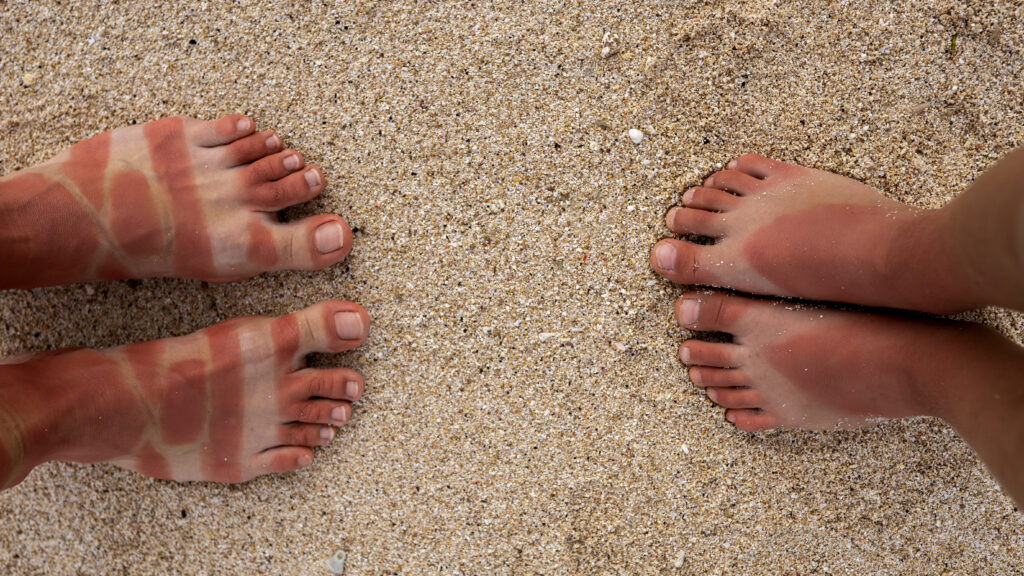How to handle common summertime pests and ailments; photos by CC-BY-SA-4.0 via Wikimedia Commons

I love to give my kids as much time outdoors as possible during the summer. We’re all in a better mood after a day of fresh air and exercise, and there are many great places around Rochester to go for a hike and appreciate the wildlife all around us.
Studies show that outdoor play improves gross motor skills and emotional regulation while decreasing stress and rates of childhood obesity, according to Doctor Laura Kopp of Panorama Pediatrics. Here are some tips to stay safe this summer so you can enjoy all the fun.
SUNBURNS
Kopp warns, “If you are feeling hot, your child is, too!” Babies under six months of age should be kept out of direct sunlight. Choose a sunscreen made for kids with a sun protection factor of 30 or higher. There is no such thing as a waterproof sunblock so be sure to reapply every hour or so, especially if you’re swimming.
Kids don’t have to get a sunburn to be harmed by the sun’s rays and it’s the invisible UV rays that cause the most damage. Sun hats and umbrellas are great during the peak hours.
Burns can leave the skin red, warm, and painful. Cool compresses, a cool bath, or acetaminophen can relieve the pain. Severe burns can cause blistering, fever, chills, headache, dehydration, and fainting. If your child experiences more severe symptoms, you’ll want to call your pediatrician.

POISON IVY
I love exposing my kids to plant life, but I am terrible at identifying poison ivy. I still find myself reciting “leaves of three: let it be.” I know the leaves have three separate leaflets with a longer central stalk. But it comes in many shades of green and can be hard to tell apart from harmless species. It can look like a thick vine, other times it looks like a bush or shrub and sometimes it carpets the ground.
If you’re like me, play it safe by wearing long sleeves and closed-toed shoes when hiking and gloves when gardening. Try not to touch any leafy plants and wash your hands well with soap after a hike. Dish soap is the best for removing urushiol, the oil found in poison ivy, oak, and sumac.
Contact with poison ivy might look like an itchy, red rash that starts within four hours to four days of touching the plant and blisters that ooze clear fluid. You might see bumps that look like streaks on the skin or a crusty rash. Are you itching yet just reading this?
If you do suspect your child has been exposed, wash off the oil with soap. Scrub fingernails and clean all items including shoes as the oil can remain for months on anything it touches. Encourage children not to scratch or break the blisters. Poison ivy is not contagious. New rashes mean you’ve encountered the oil again.
Mild rashes can be treated at home—cool compresses and calamine lotion will help with the itching as well as oatmeal in the bath. Call the doctor if the rash is severe or widespread. Call 911 if there is swelling of the tongue, chest tightness, or trouble breathing.
TICKS AND BUGS
Our family loves to hike, but ticks are prevalent and can carry illnesses such as Lyme disease. These tiny, unwelcome visitors live in long grass, piles of leaves, or wooded areas. Even though we keep our grass cut short, they love to hitch a ride to our yard on deer and other wildlife. Ticks do not fly or jump, but they easily latch on to anything that brushes against them.
Light-colored clothing makes it easier to spot them crawling, and tucking pants into socks keeps ticks from getting at your child’s ankles. Wear a hat and tuck away long hair to prevent ticks from getting onto the hair and scalp.
After a hike, do a tick check on all people and pets. Ticks like to hide in places like armpits, belly buttons, behind the knees, in and around the ears, and along the hairline. Ten minutes in the dryer will kill any ticks on clothing and if you can get the kids in the shower right away, most ticks will wash right off before getting the chance to attach.
If you do find a tick, remove it as quickly as possible using tweezers. Grab the tick as close to the skin as you can and steadily pull the tweezers upward to remove it without twisting or jerking.
Symptoms of tick-borne illness may include a “bull’s eye” rash around the bite area, fever, fatigue, headache, and joint pain or swelling. Not all ticks carry diseases and most children who are bitten by a tick will not get sick. Daily tick checks and nightly showers will give you peace of mind and help you enjoy the outdoors this summer.
Kopp reminds us that the power of play is the gift that continues to give for all ages. She says, “Children who play outside develop into creative, curious thinkers who are mindful of their environment. So, enjoy our beautiful summers!”






